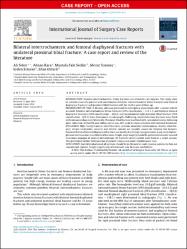| dc.contributor.author | Şeker, Ali | |
| dc.contributor.author | Kara, Adnan | |
| dc.contributor.author | Seçkin, Mustafa Faik | |
| dc.contributor.author | Sönmez, Mehmet Mesut | |
| dc.contributor.author | Ertürer, Erden | |
| dc.contributor.author | Öztürk, İrfan | |
| dc.date.accessioned | 10.07.201910:49:13 | |
| dc.date.accessioned | 2019-07-10T19:37:09Z | |
| dc.date.available | 10.07.201910:49:14 | |
| dc.date.available | 2019-07-10T19:37:09Z | |
| dc.date.issued | 2014 | en_US |
| dc.identifier.citation | Şeker, A., Kara, A., Seçkin, M. F., Sönmez, M. M., Ertürer, E. ve Öztürk, İ. (2014). Bilateral intertrochanteric and femoral diaphyseal fractures with unilateral proximal tibial fracture: A case report and review of the literature. International Journal of Surgery Case Reports, 5(8), 509-512. https://dx.doi.org/10.1016/j.ijscr.2014.06.001 | en_US |
| dc.identifier.issn | 2210-2612 | |
| dc.identifier.uri | https://hdl.handle.net/20.500.12511/1343 | |
| dc.identifier.uri | https://dx.doi.org/10.1016/j.ijscr.2014.06.001 | |
| dc.description.abstract | INTRODUCTION Bilateral intertrochanteric femur fractures are relatively rare injuries. This study aims to present a case of a patient with simultaneous bilateral intertrochanteric femur fractures and femoral diaphyseal fractures and proximal tibial fracture with his twelve years follow-up. PRESENTATION OF CASE A 44-year-old man presented to emergency department after a motor vehicle accident. Bilateral intertrochanteric femur fractures (OTA classification - 31A.1.2) and bilateral femoral diaphyseal fractures (OTA classification - 32A.2) and nondisplaced right proximal tibial fracture (OTA classification - 41B.1) were determined in radiographs. Following closed reduction, fractures were fixed with intramedullary nails bilaterally. Proximal tibial fracture was fixed with cannulated screws following open reduction. At twelfth year follow-up he was able to do his daily activities with minimal limitation. DISCUSSION High energy traumas, stress fractures, systemic disorders (osteomalacia, chronic renal failure), steroid treatments, seizures and electric injuries are possible causes for bilateral hip factures. However bilateral femoral diaphyseal fractures are mostly due to high energy traumas. Long-term biphosphonate use may also cause bilateral fractures. Single-stage surgery should be performed in order to avoid secondary damages of surgical interventions. All fractures of our patient were fixed in a single session. This prevented further deterioration of patient's status and made rehabilitation easy. CONCLUSION Careful evaluation of all systems should be performed in multi-trauma patients to find out concomitant injuries. Single staged surgical treatment may decrease morbidities. | en_US |
| dc.language.iso | eng | en_US |
| dc.publisher | Elsevier | en_US |
| dc.rights | info:eu-repo/semantics/openAccess | en_US |
| dc.rights | Attribution-NonCommercial-NoDerivs 3.0 Unported | * |
| dc.rights.uri | https://creativecommons.org/licenses/by-nc-nd/3.0/ | * |
| dc.subject | Bilateral | en_US |
| dc.subject | Femoral Diaphyseal Fracture | en_US |
| dc.subject | Intertrochanteric Fracture | en_US |
| dc.title | Bilateral intertrochanteric and femoral diaphyseal fractures with unilateral proximal tibial fracture: A case report and review of the literature | en_US |
| dc.type | article | en_US |
| dc.relation.ispartof | International Journal of Surgery Case Reports | en_US |
| dc.department | İstanbul Medipol Üniversitesi, Tıp Fakültesi, Cerrahi Tıp Bilimleri Bölümü, Ortopedi ve Travmatoloji Ana Bilim Dalı | en_US |
| dc.authorid | 0000-0003-1259-6668 | en_US |
| dc.identifier.volume | 5 | en_US |
| dc.identifier.issue | 8 | en_US |
| dc.identifier.startpage | 509 | en_US |
| dc.identifier.endpage | 512 | en_US |
| dc.relation.publicationcategory | Makale - Uluslararası Hakemli Dergi - Kurum Öğretim Elemanı | en_US |
| dc.identifier.doi | 10.1016/j.ijscr.2014.06.001 | en_US |
| dc.identifier.scopusquality | Q3 | en_US |



















